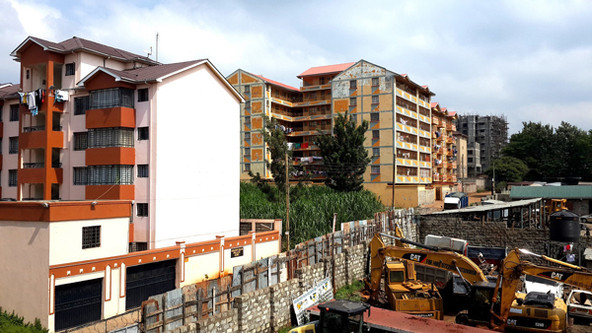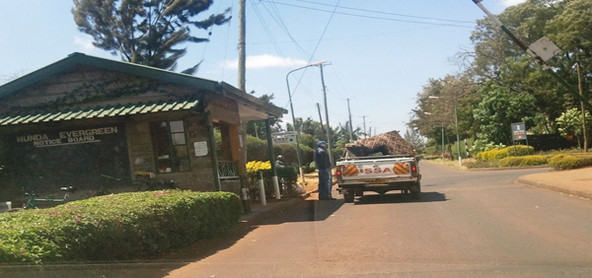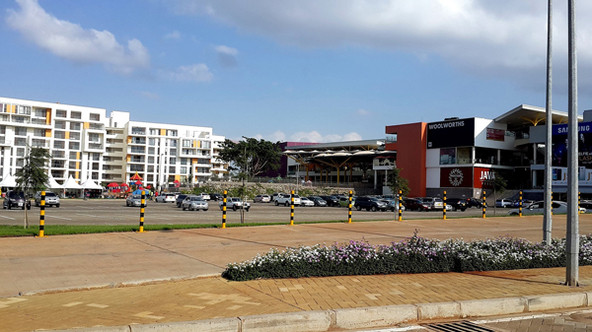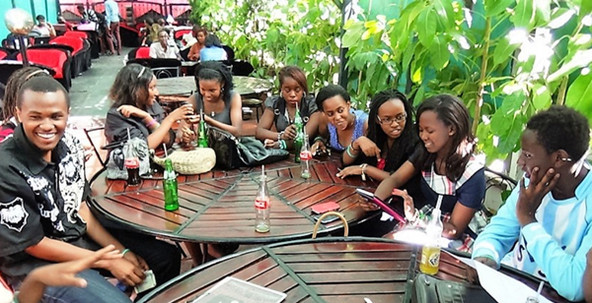It’s Saturday, December 19, 2015. Several cars are stopped on the narrow country road off Kiambu Road, a few miles north of Nairobi. This country road has existed for decades, but has never really been used by cars. Instead, farm workers from nearby villages used the road on foot on their way to the coffee farms on Kiambu Road. In the last five years, however, almost everything has changed. The coffee farms are largely gone, replaced by real estate developments of all kinds—stand-alone mansions, six-story apartment buildings, gated housing developments, and—to service the people moving into these formerly uninhabited farmlands—strip malls, nightclubs, gas stations, and family-themed restaurants.
 Mansions are cropping up in former farmlands. (Photograph by Jackie Kairo)
Mansions are cropping up in former farmlands. (Photograph by Jackie Kairo)
There is a car accident. The narrow country road barely accommodates two-way traffic, hence the backup. A young woman, clearly intoxicated, has hit another car with her BMW while exiting the gated community aptly named Edenville. The driver of the other car is furious. Since there’s nowhere for us to go until the road is cleared, my niece, nephew and I step out of our car to watch the drama unfold. The young woman is incoherent, but we manage to make out that she was on her way to visit her father at the Nairobi Hospital, that she lives in the United States, and that she would have flown back the day before if her father hadn’t been rushed to the hospital. “Summer bunny,” someone scoffs. I later learn that Kenyans use this term unflatteringly to refer to Kenyans who live abroad, but swoop into the country for vacation with their foreign currency, accents, and manner. The young woman refuses to exchange documents and attempts to get back into her car. The other driver, a man, pulls her out. She apparently doesn’t have a Kenyan driver’s license. She warns the other driver that she is cousin to Uhuru Kenyatta, the Kenyan president. The situation escalates. My nephew, an investment banker in Nairobi, steps up to assess the damage. He provides an estimate of KSh. 5,000 (about $50). Both agree to the amount; she will settle the damage in cash. It’s striking that throughout the incident, no one even hints at the possibility of calling the police. As the young woman reaches for her purse, she laments that she can’t drive, but she still needs to get to the hospital. My niece, a second-year architecture student at the University of Nairobi, offers to get Uber for her…
This is the Kenya of 2015, with much-heralded development and a fast-growing economy. The World Bank forecasted a GDP growth of 5.4 percent for 2015 and 5.7 percent for 2016. In a Bloomberg survey, economists considered Kenya the third-fastest growing economy in the world in 2015, with a projected GDP growth of 6 percent. There are visible signs of this growth everywhere: Kenyans are increasingly using technology to connect and do business; the mobile phone penetration in 2014 was reported at 80.3 percent; most mobile subscribers now use mobile money transfer services; and many young people get their news via Twitter, post selfies on Instagram, and are even swiping right or left on Tinder.
These developments notwithstanding, there is evidence of imbalances and income inequality everywhere. Even as Bloomberg was predicting a high growth rate in 2015, it cautioned that unemployment and poverty remained “stubbornly high, with over 40 percent of Kenyans living below the poverty line.” In the malls, gas stations, and supermarkets, there is a notable presence of underemployment. In one small-sized supermarket, for example, I noticed a worker for every few shelves, ostensibly restocking goods, but really acting as security against theft.
Are you enjoying this article? Read more like this, plus SSIR's full archive of content, when you subscribe.
Despite a growing middle class, Kenyan wealth is still held by a tiny, politically connected investor class. According to a 2014 report, just 8,300 individuals—an astounding .02 percent of Kenya’s population of 46 million—control two-thirds of the country’s economy. Additionally, since 40 percent lives below the poverty line, the middle class, although growing steadily, is still quite limited. The superwealthy are the investors in the booming real estate, and home ownership—essential for wealth accumulation—is out of reach for the young middle class.
 Mostly unregulated real estate development fills the needs of the growing middle-class. (Photograph by Jackie Kairo)
Mostly unregulated real estate development fills the needs of the growing middle-class. (Photograph by Jackie Kairo)
Mumbi, a young engineer, lives in a three-bedroom rental apartment for $300 a month. I wondered why she couldn’t buy a similar apartment instead. She explained, “Mortgage rates are sky-high, but the superrich who develop real estate use cash, so they are not in the mortgage market. My landlord can make money renting my apartment out for $300, but if I were to buy the same apartment with a mortgage, I would have to pay more than $1,000 a month, which I cannot afford. It’s impossible for many of us to own homes.” Indeed, the mortgage rates in 2013 and 2014 ranged from 8 to 21.3 percent, with an average of 15.8 percent. Additionally, most mortgages are on variable interest. So, how do the wealthy and the middle class live among so many desperately poor people? They try not to. The Kenyan rich have figured a way to create both a physical and psychological distance between themselves and the poor. Take Edenville, for example: In a move of strategic genius, the developer installed a high stone wall and an electric fence, and paved the half-mile section of the (public) country road that connects residents with the main road to Nairobi. As long as residents stay within their well-serviced community, or turn left from the gate and onto the paved section of the road, they need never meet their poor neighbors to the right, many of whom live on $2 a day. Similarly, the residents of upscale Runda blatantly put up a gate on the public road that runs through their neighborhood, allowing only private cars through and effectively banning poor citizens from a public space. (Complaints by activists eventually had the gate removed.
 A gated public road in Runda. Complaints by activists had it removed. (Photograph by Henry Njoroge)
A gated public road in Runda. Complaints by activists had it removed. (Photograph by Henry Njoroge)
Public Problems, Private Solutions
After decades of public mismanagement and the resulting poverty, the country faces many social problems. The rich and the emerging middle class resolve public problems with private solutions. A few examples:
- Education: Those who can afford it opt out of the public school system. Those who can’t afford private schools, but have some disposable income hire private tutors. Often, the tutors also teach in the public schools, which leads to the question: What incentive do they have to teach during official hours, or to not discriminate against children whose parents cannot afford to pay them as private tutors? I raised this concern with a parent of a public primary school child who shrugged and said, “Everyone has a side hustle.” The biggest side hustle of all in the Kenyan education system is an official one. Public universities, long revered for selectivity devised a “parallel program” about a decade ago whereby they admit students who might not otherwise qualify for the regular track or/and who can pay the high tuition rates, rather than rely on the government-backed students’ loan program. The parallel programs are basically private universities within public ones. And since they are accelerated, students finish faster than their contemporaries in the regular program. Being from socially connected families, students in the parallel program also get better jobs.
- Crime and security: In light of a corrupt police force, many citizens have turned to vigilantism, high walls, and electric fences to protect themselves from crime. The private security industry is booming. Many middle class homes have a security guard. In supermarkets and malls, security is visible and intrusive. Bags are inspected and electronic frisking is a regular thing. Part of this is due to the fear of terrorism, but a lot has to do with crime.
- Inadequate public transportation: The major public transportation mode for most Kenyans has always been the matatu minibus. In Nairobi, a city of 3.5 million, which accounts for 60 percent of GDP and half the labor force, public transportation is woefully inadequate. The emerging middle class resolves the public transportation problem with private cars, often imported, reconditioned ones. Unfortunately, many roads have remained exactly the same as in the 1960s and simply can’t support the impact of so many cars.
The Highways to Nowhere
 Off Kiambu Road, Garden City Village incorporates a mall, an office park and residences. (Photograph by Jackie Kairo)
Off Kiambu Road, Garden City Village incorporates a mall, an office park and residences. (Photograph by Jackie Kairo)
If you speak to anyone living in Nairobi and its environs today, they will almost inevitably mention the traffic jams that afflict all roads leading to downtown. A friend who owns a human resources consultancy with offices in the Karen suburbs, 15 miles west of downtown Nairobi, told me that she had converted some of her office space to sleeping quarters. “It simply got ridiculous for me to have a total daily commute of over five hours from where I was living in a downtown apartment. I decided that I would rather live like a student.” She explained that her decision wasn’t that uncommon, especially since the zoning laws were fairly lax. Indeed, city-center office occupation has gone down; businesses have found many offices impossible to run under current traffic conditions.
My friend’s decision to have an office-based “home” is just one example of how the fast-growing economy is not necessarily translating to a better quality of life among Kenyans. The inflation rate stood at 6.77 percent in January 2016, and food and household consumer goods are very expensive. This had added further strain on the poor, who are both a part of—yet excluded from—the new global economy. According to the World Health Organization, the diseases and conditions normally associated with affluence—obesity, heart disease, diabetes, stroke, and cancer are on the increase in Kenya. These diseases co-exist with health conditions typically associated with poverty—malnutrition, infant mortality, and communicable diseases—and illustrate the absurd duality of existence in the country.
Everyone for Themselves, God for Us All?
December 23, 2015. My niece is driving me to a bank in downtown Nairobi. Google Maps shows the distance as 12 kilometers (7 miles). About a mile in, we come to a standstill—a traffic bottleneck. There is a matatu minibus in front of us and a stalled car in front of it. Our exit is coming up, and we must change lanes. It is, however, impossible to change lanes without scraping the matatu in front of us. We must back up first. My niece puts the car in reverse, and gently backs up into the small space between her car and the car behind her. The matatu conductor seizes the opportunity, jumps out of the minibus and directs his driver to back up, coming so close that my niece cannot change lanes. The car behind us manages to change lanes, and my niece quickly backs up before the space is occupied by another car, but the matatu backs right back into her, blocking her. She opens the window and screams, “I’m trying to change lanes and you keep blocking me!” “Ah, mrembo [babe],” he sneers. My niece laments her small car and her having neglected to ask her brother to switch cars so that she could drive his SUV. “No one bullies me when I’m driving Henry’s car.” The minibus changes lanes. We are now behind the stalled car so all we have to do is to find someone who is willing to give us way. But every time my niece inches closer to the next lane, the car behind moves forward to block us. With the indicator on and my hand out requesting to be let through, it takes almost five minutes before a car gives us way.
That’s when it hits me: I’m observing the principle of sub-optimization in (very slow) motion. Sure, the road has design flaws, but the traffic jam also has a human element. Everyone looks out for themselves, and the unwillingness to allow others to change lanes only exacerbates the traffic congestion. Few seem to recognize how interconnected they are, or how their actions affect the whole system (including themselves), or how everyone might fare better if each individual acted differently. I had observed similar behavior elsewhere, like in supermarkets where people would avoid getting in line if they could get away with it. For all of Africa’s much-touted “community spirit” and Kenyan religiosity, there is little charity to be seen here. There is an almost crass individualism accompanied by little interpersonal trust. It seems like the more economically better off people have become, the less honest and less generous they’ve become. No wonder the society has turned to private solutions for public problems. In this new economy, humanity seems to be taking a backseat.
Society-Oriented Philanthropy: A Flawed Model
For decades, billions of development aid dollars have been poured into Kenya and other developing countries. This money mainly goes to public projects such as schools and health clinics. Projects that don’t involve physical infrastructure, such as civic education, are also society-oriented—beneficiaries are taught about the importance of democracy and the mechanics of voting with a view to making society better.
But these projects have done little to uplift recipients from poverty or improve their quality of life. The failures and the reasons for the failures are well documented. They include poor planning and implementation of projects; corruption and mismanagement of funds by public officials; a lack of agency among community members; the manifestation of the "dependency syndrome"; and the lack of pride, dignity, or a feeling of self-worth among beneficiaries.
I posit that treating beneficiaries as a collective and not as individuals has just as much to do with the failure. As illustrated by the traffic jam situation above, individuals often think of their personal needs as separate from the needs of the wider community. Given that, it’s not surprising that many society-oriented projects fail. In Kenya, there is a common phrase Ni mali ya umma (“It’s public property”). The phrase represents the mentality that drives the plundering of public resources and the wonton destruction of public property. It better translates as: “What do you care—it’s not your personal property.”
Mind Over Machinery
While there’s no denying its structural roots, it’s also apparent that collective mindsets contribute and perpetuate poverty. Yet development projects seek to remedy the symptoms of poverty. USAID, for example, has launched six Grand Challenges for Development: Fighting Ebola, Securing Water for Food, Saving Lives at Birth, All Children Reading, Powering Agriculture, and Making All Voices Count. The organization’s fundamental belief is that the appropriate application of science and technology can lead to the transformation of international development. Perhaps. But the attainment of each of these goals depends on the way everyone involved fundamentally thinks about the goals’ importance. Technology is a tool that humans apply. Why not transform human thinking first? The best technology can’t overcome a lack of a personal buy-in to these worthy goals.
Psychologists, philosophers, spiritual teachers, and great leaders all tell us, “We are what we think we are.” A “power of the mind” search on Amazon returns 168,815 results, including books on the subconscious mind, neuroplasticity, mind-body connection, spiritual well-being, self-belief and achievement, creativity, brain training, and habit change. Yet, in seeking to tackle poverty, we give almost no attention to mindsets among those affected. In fact, the fundraising success of international NGOs is dependent on showing poor people as helpless recipients of good from foreigners. The images and symbolism used to sell this message to western audiences aren’t lost on the poor in developing countries—particularly now, with the expansion of technology. How can children who grow up seeing themselves as poor and helpless grow up with the self-esteem necessary to become independent adults? Even when they are thriving, people who have grown up with this self-perception find it difficult to break from the habits and thoughts they formed as children. The Kenyan middle class, for example, stand aside and watch international NGOs and spring breakers help the poor in their communities. They just do not see themselves as potential givers.
What Next?
Clearly, a fast-growing economy isn’t sufficient for improving citizens’ quality of life, neither is technology a panacea for poverty. We need a fresh approach to development—in Kenya and beyond—that focuses on humans as individuals, and targets children early in life. Below are few suggestions:
- Incorporate social and emotional learning (SEL) in school curricula. Academic learning is important in Kenya—as it should be. Primary school pupils have long school days, after-school tutoring, and sometimes attend school on Saturdays. Children preparing for national exams have extended school years. But there is nothing in the curriculum that teaches students how to actually live with other people or make appropriate personal decisions. Children often stumble through life, taking cues from peers or family members who may have grown up under colonial rule or are still entangled in tribal alliances. SEL teaches skills related to self-awareness, self-management, social awareness, interpersonal relationships, and decision-making. It helps children develop empathy, kindness and compassion, positive self-regard, self-discipline, and the skills of quieting and self-reflection. In his establishment of "How to Live Schools,” Paramhansa Yogananda recognized the need for this type of education. Incorporating SEL would help children recognize their common humanity and shared values, a mindset that, if widespread, would help society to work toward resolving social problems.
- Teach critical thinking. The Kenyan school system, even at university level, is almost wholly focused on examinations. Curricula emphases rote memory, and there is no place for dissent or critical thinking. The elder-centric culture also calls for absolute deference to the teacher. When students graduate, they are ill-equipped to translate memorized knowledge into problem solving skills. In his 2014 TED Talk entitled, “How to Think, Not What to Think,” Jesse Richardson suggests that engaging children in problem solving keeps them curious. Curiosity is self-powering, and you don’t need to force curious children to learn.
- Foster creative expression. Kenya’s focus on examinations also means that the curriculum has little room for creative self-expression. Schools largely ignore the arts or reserve them for the “talented.” Play is often discouraged as a waste of valuable time that could be used in studying. Yet research now supports the notion that arts are an important contributor to personal growth and academic achievement. Children who lack an outlet for self-expression are unable to develop the creativity needed to resolve social problems.
- Inspire children with positive heroes. Great leaders like Mahatma Gandhi, Nelson Mandela, and Martin Luther King Jr. used inspiration to change the course of history. Kenyan children grow up listening to stories of public corruption, experiencing its effects, and seeing all kinds of negative behavior around them. Consequently, they have no sense of pride in their country. Add to this the negative images of Africa, and children grow up with a collective low esteem. It’s difficult for children to aspire to be good when they have no one to inspire them. Even fictional characters that inspire children to reach for greatness in the West are not available to these children. There is a need to teach children about local heroes such as the colonial-era freedom fighters, as well as create inspiring narratives in the form of storybooks, films, and TV programming that feature local and familiar characters.
- Mentor children. Research indicates that mentoring acts in several ways to enhance personal development: Mentors assure you that you can be anything you want to be, act as an example of what you could be, challenge you to do better, give you courage to pursue your goals, empower you by focusing on your particular needs, and help you to push boundaries. Young Kenyans would do well with mentors who look like them and have had similar life experiences.
Scalability
In deciding whether to support a project, investors consider the all-important metric of scalability. In economic development and improving quality of life, the human potential has infinite scalability. If people develop and act from values such as positive self-regard, empathy, integrity, and compassion, there will be more fair dealing, less plundering of public resources, and honest attempts to do the right thing. Under these conditions, both personal and community success are enhanced. As social conditions improve, people become proud of their community and strive to improve it further. Additionally, those who espouse these values pass them on to their children. Infinite scalability.
Christmas Eve, 2015. In Kiambu town, jostling low-income shoppers from nearby villages buy wheat flour, meat, and various delicacies in preparation for the annual Christmas family feast. A few miles away, in the ultra-modern Garden City mall, middle class shoppers angle for limited parking spaces. Many feel a little richer this Christmas, but are they better off?
 The middle-class life: Young Kenyans enjoy a day out at an outdoor café. (Photograph by Jackie Kairo)
The middle-class life: Young Kenyans enjoy a day out at an outdoor café. (Photograph by Jackie Kairo)
Support SSIR’s coverage of cross-sector solutions to global challenges.
Help us further the reach of innovative ideas. Donate today.
Read more stories by Shiko Gathuo.

